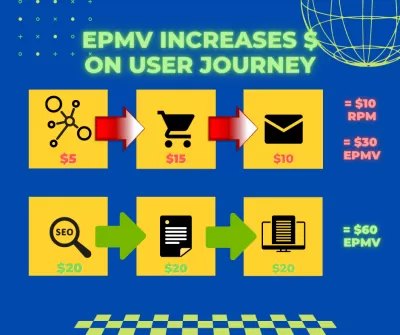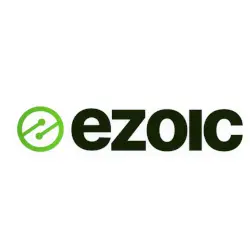EPMV vs RPM: What's the difference?
Initially, the difference between these two indicators is that EPMV is used in analytics from Ezoic, and RPM is from Google. It is from this point that we can continue to consider the differences between these two indicators.
What is RPM
Revenue per thousand impressions is the estimated revenue from each thousand impressions received. CPM revenue does not reflect your actual earnings. It is calculated by dividing the estimated revenue by the number of page views or requests received and then multiplying the result by 1,000.
The formula by which this indicator can be calculated:- If you earned approximately $0.15 for 25 page views, your CPM would be (0.15/25)*1000, which is $6.
- If you earned $180 from 45,000 ad impressions, your CPM for your ad would be (180 / 45,000)*1,000, which is $4.
CPM revenue is used in many advertising programs. With it, you can compare revenue from different channels.
What is EPMV?
EPMV stands for Earnings Per Thousand Visitors. This is how much money you earn for every 1000 visits to your website. It is calculated as follows:
- In March, your revenue was $1,000 (AdSense) + $5,000 (ADX) + $500 (native ads) = $6,500.
- March sessions - from Google Analytics - totaled 1,000,000 visits.
- EPMV was $6,500 / (1,000,000 / 1,000) = $6.50 EPMV.
You can calculate your website EPMV that way and compare the two metrics easily.
The income generated by a website depends on many factors such as:
Number of visits, number of ads shown during each user session, bounce rate of each landing page, number of pages viewed per visit, sources of outbound traffic, time of day, ad type (display, native, embedded), RTB bid, ad parameters, viewport size, user connection speed, etc.
However, all too often publishers focus on RPM – page revenue per 1000 page views.
Why EPMV
Users really need a metric that takes into account all the factors that affect revenue – something that tells you about the revenue you actually get from your visitors, your profit as a business. This indicator is EPMV.
EPMV automatically takes into account the impact of your ads on bounce rate and page views per visit. If the bounce rate goes up, or pv/v goes down, then this is reflected in the EPMV.
Whether you use Ezoic or not, you need to keep track of your EPMV to account for seasonal changes in the traffic going to your site. You need to know how well the site is monetizing, whether or not you had a lot of traffic.
EPMV or revenue per session is the only reliable way to measure revenue after taking into account external factors such as seasonality and changes in UX.
It's much more important to keep track of the value you create from each website visitor rather than trying to manage individual ad prices - CPM or eCPM - or manage page return / RPM or use daily revenue as a benchmark.
RPM, CPM and daily revenue monitoring can give you a signal, but also tend to give false positives (e.g. higher RPM but lower total revenue) and are not a reliable or scientific way to monitor your monetization success.
eCPM and RPM distort real income
In most industries, indicators that reflect the success of stakeholders have long been accepted. This is not the case in the advertising and publishing industry. This becomes apparent when you start talking to publishers, ad teams, and site owners and cite eCPM (Effective Cost Per Thousand or Thousand Ad Impressions) versus RPM (Revenue Per Thousand Page Views) as key metrics to determine if the site's income represents income success.
The error in this equation is that you think that eCPM or RPM gives you a metric that is true north for the site's total revenue.
CPM or Effective CPM?
What is the difference between CPM and eCPM? CPM is the cost per thousand impressions for an individual ad unit. eCPM, or effective cost per thousand impressions, is the total cost of all ads on a page on a publisher's website.
CPM is the price paid for one ad slot, while eCPM is the total price paid for all ads on a page.
What is the difference between profit and advertising revenue? Nothing but semantics really, both terms are used to describe the monetization of ad inventory by publishers.
Measure EPMV instead of eCPM or RPM
Considering seasonality, mobile penetration, AMP, and a million other variables, you need a metric that can make sure you're always moving in the right direction. This means you take into account revenue, visitors, bounce rate, and more.
The best metric for publishers is EPMV (Earning Per Thousand Visitors or “Revenue Per Session”). EPMV will automatically take into account bounce rate and page views per visit. This is the only way to measure whether revenues are really moving in the right direction, despite any external factors such as seasonality.
Frequently Asked Questions
- What is more important to track: eCPM vs RPM?
- To successfully maintain your site, you need to track all metrics and eCPM and RPM. You need to monitor and analyze changes in traffic, audience growth and income for your site. You need to know how well the site is monetizing, whether or not you had a lot of traffic.
- Why is it important to measure a site's EPMV?
- EPMV is the most important indicator for the site, which will show you all the factors that affect your income. That is, you will be able to analyze the impact of your ads on the bounce rate and the number of page views per visit.
- What determines the income from the website?
- The income from a website depends on many factors. For example, the number of visits, the number of ads shown during each user session, the bounce rate of each landing page, the number of pages viewed per visit, sources of outbound traffic, time of day, ad type (display, native, embedded), RTB bid, ad parameters, viewport size, user connection speed, etc.
- What are the key differences between EPMV (Earnings Per Mille Visits) and RPM (Revenue Per Mille), and how do they impact publisher revenue analysis?
- EPMV measures the total earnings per thousand visits to a site, considering all revenue sources, while RPM refers to the revenue generated per thousand ad impressions. EPMV gives a more holistic view of site profitability, accounting for user behavior and site-wide engagement, whereas RPM focuses specifically on ad performance.

Michel Pinson is a Travel enthusiast and Content Creator. Merging passion for education and exploration, he iscommitted to sharing knowledge and inspiring others through captivating educational content. Bringing the world closer together by empowering individuals with global expertise and a sense of wanderlust.


